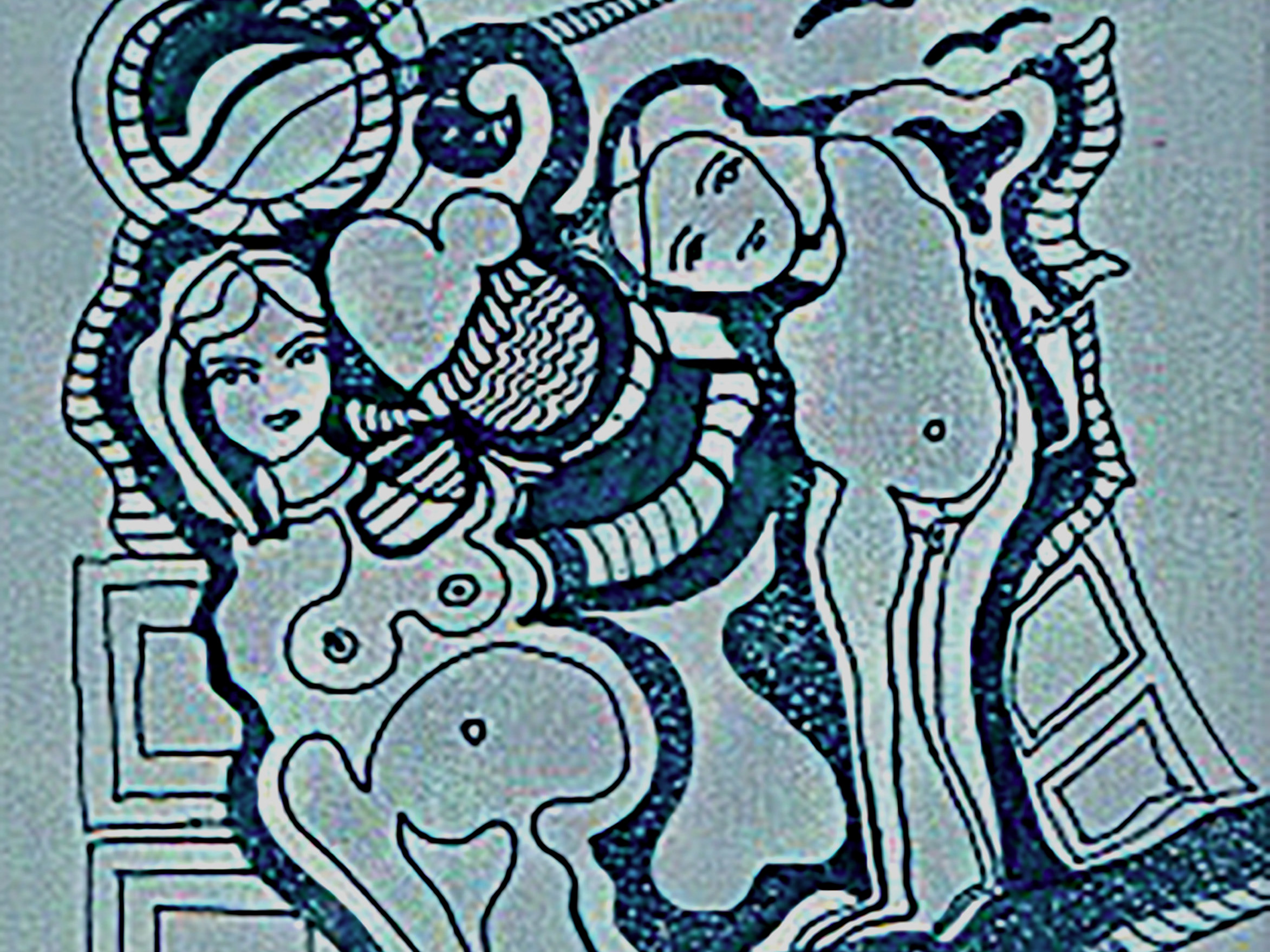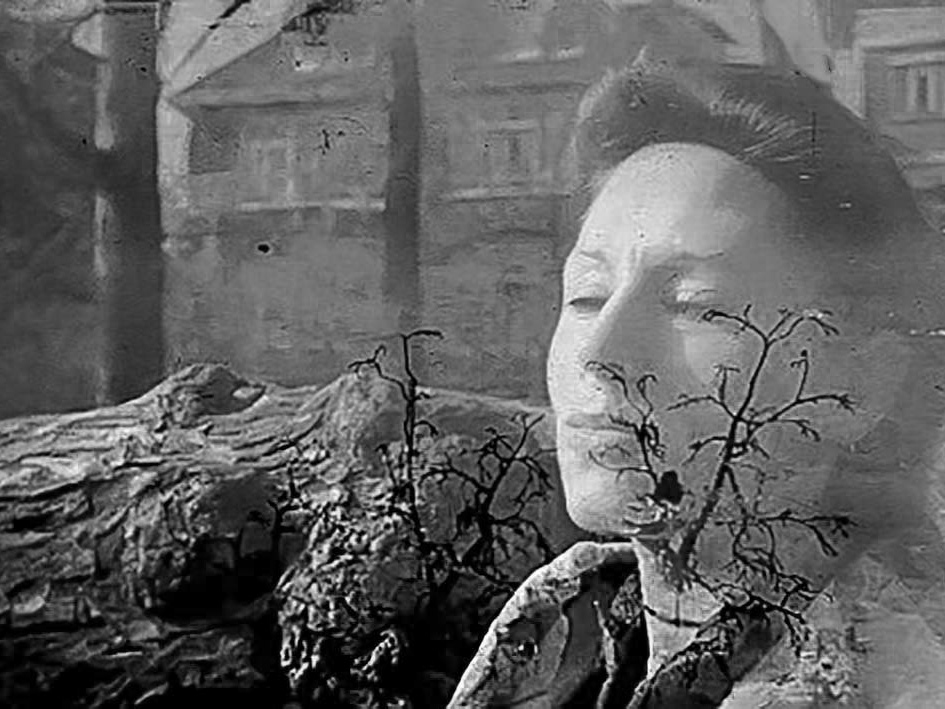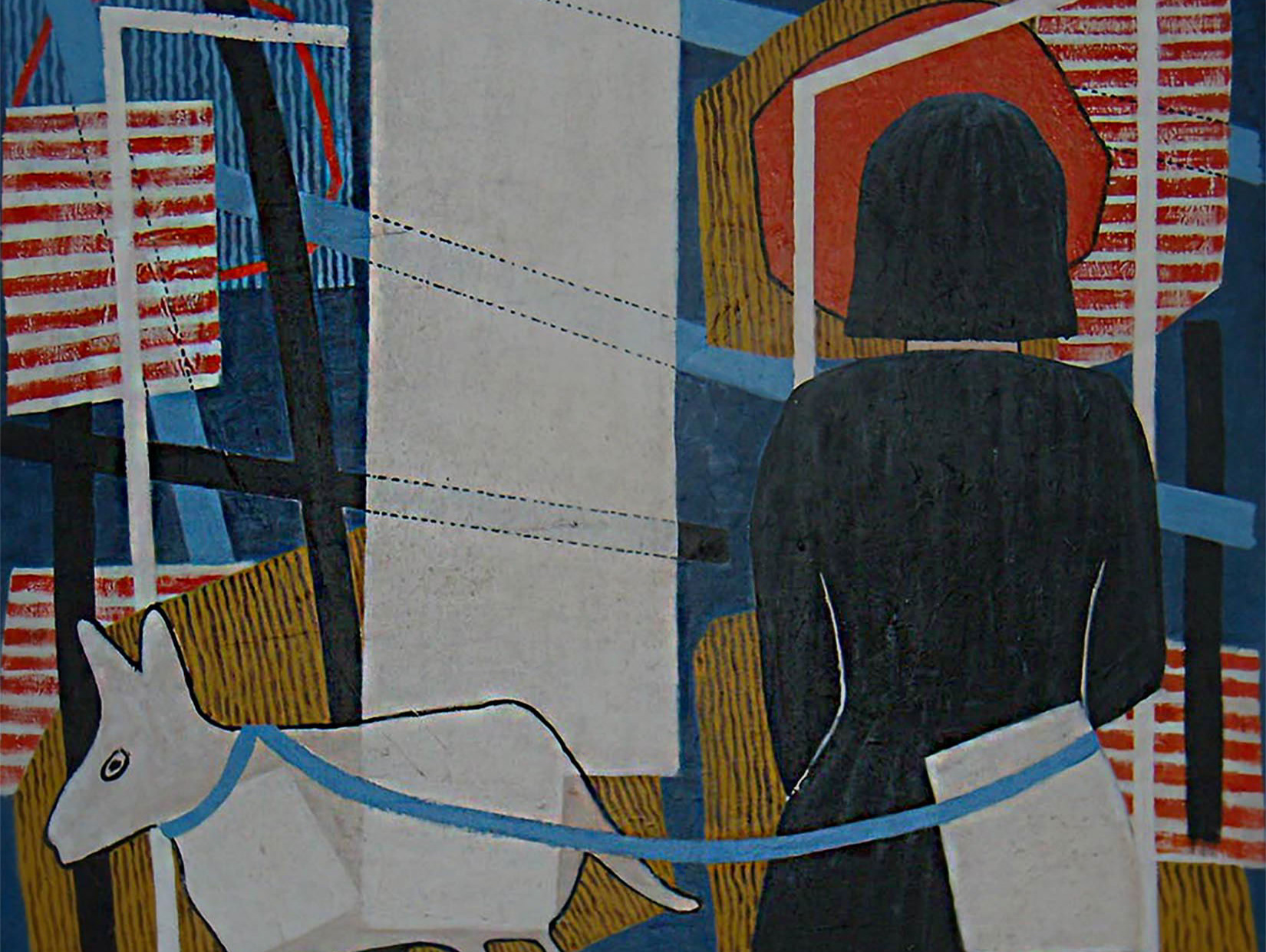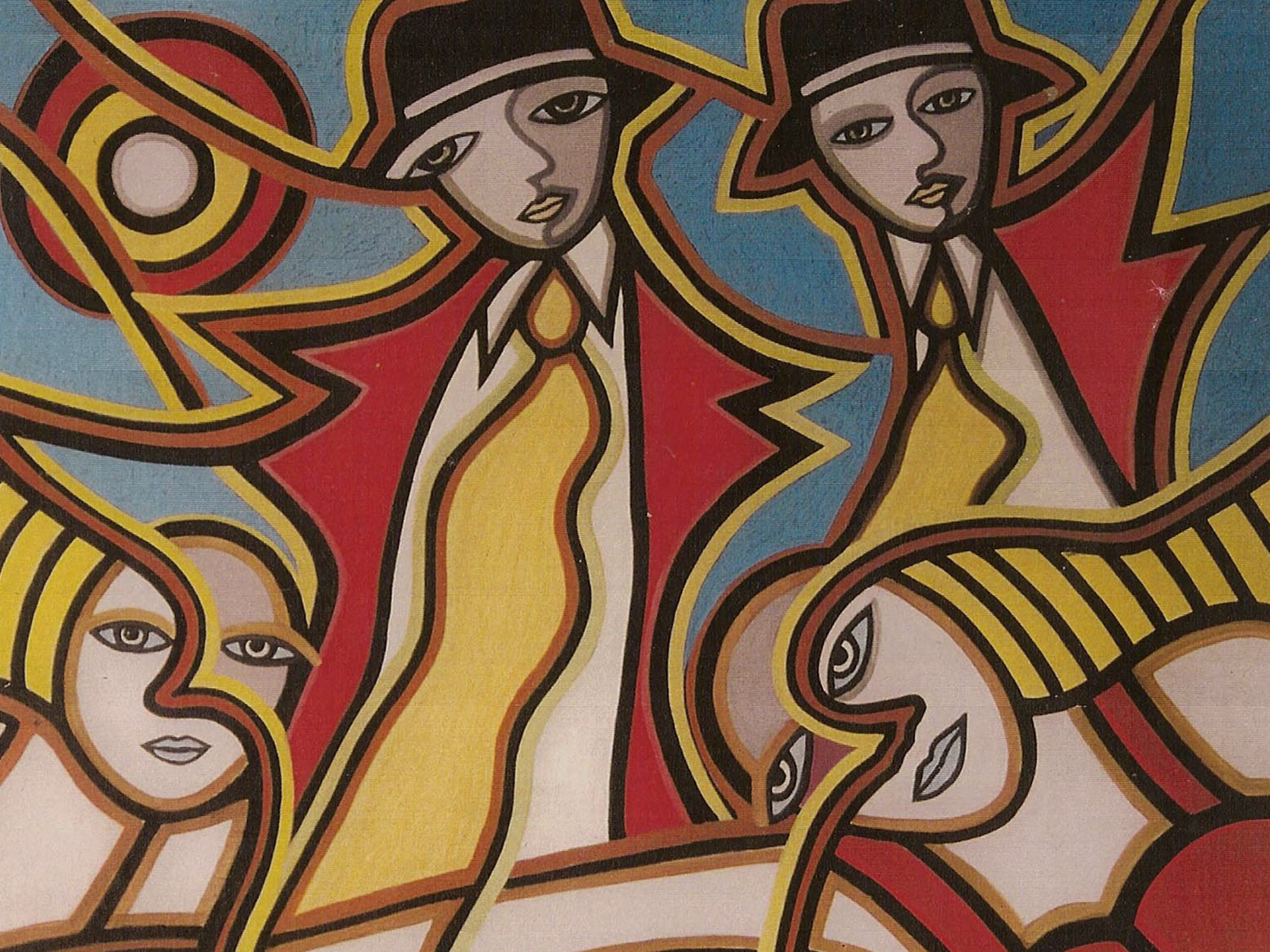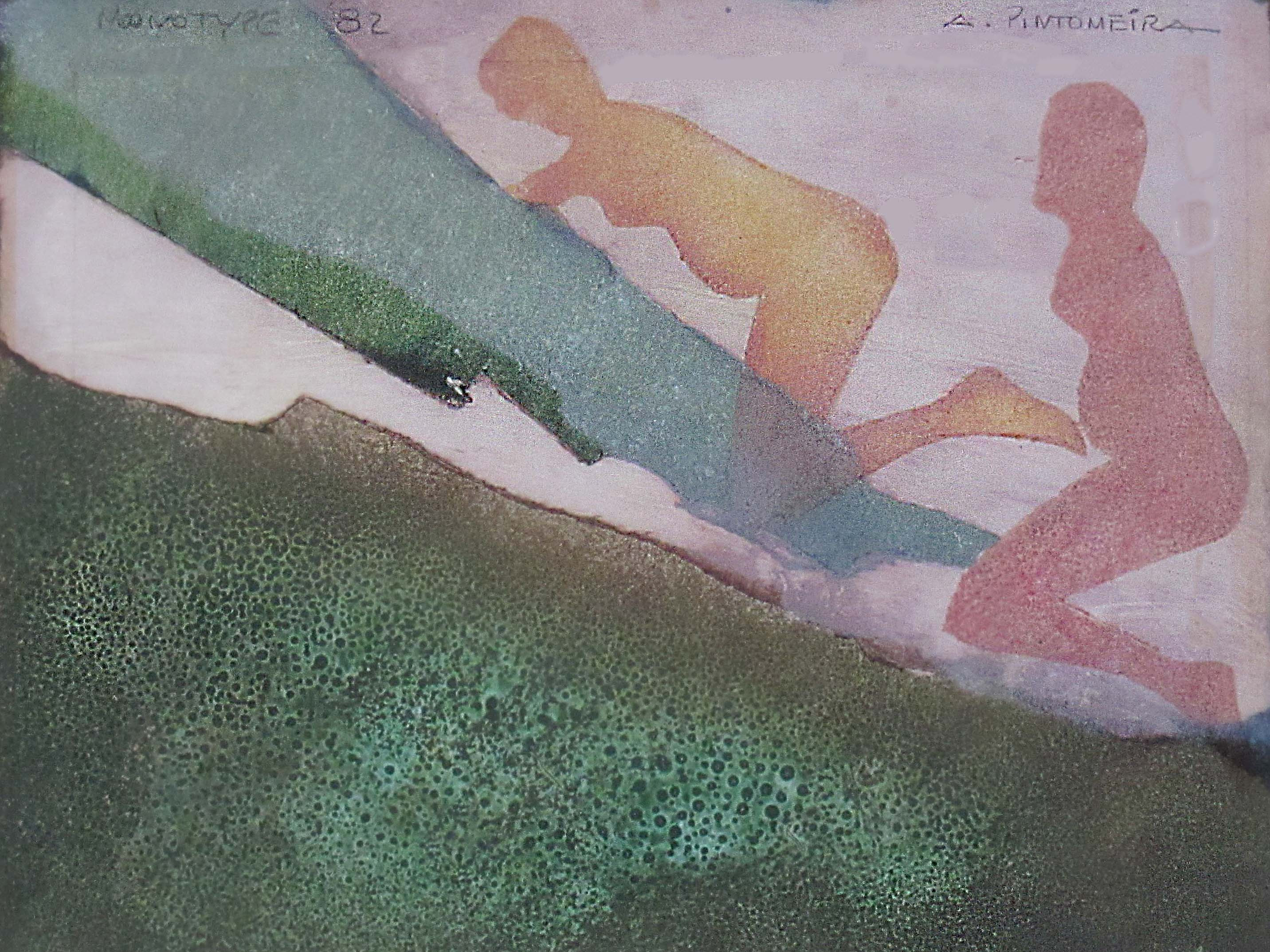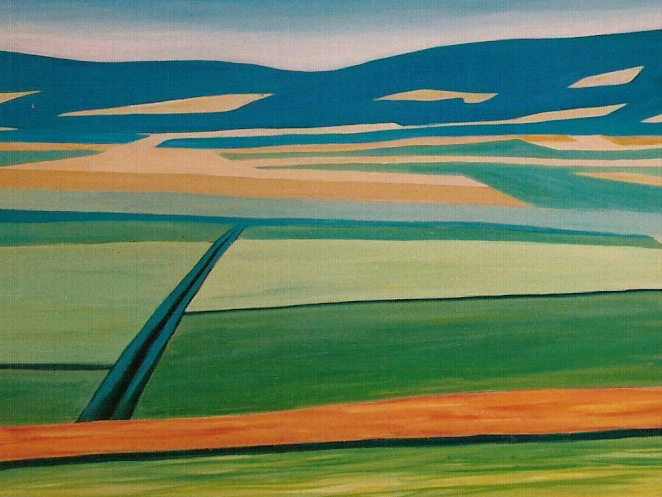EXTERIORS
2011 . 2012
During the years 2011 and 2012, Pintomeira produced in his Studio the EXTERIORS. A set of big scale artworks, being the major part composed of acrylics and mixed media on canvas. Showing, most of the times, urban scenes, looking like photographically captured, they are brought to the canvas in an aesthetical and formal conception of free imagery by mixing the characters, usually women, with the urban traffic signs and the graphism of its numbers and words. Crosswalks, stripes, streakings, lines, circles and other geometric figures complete an asphalt grey background.
EXTERIORS | acrylic on canvas | 165x185x4cm | 2012
EXTERIORS | acrylic on canvas | 140x160x4cm | 2012 | Private Collection
EXTERIORS | acrylic on canvas | 140x160x4cm | 2012
EXTERIORS | acrylic on canvas | 140x160x4cm | 2012 | Art State Collection
EXTERIORS | acrylic on canvas | 100x90x4cm | 2012 | Private Collection
EXTERIORS | acrylic on canvas | 100x90x4cm | 2012 | Private Collection
EXTERIORS | acrylic on canvas | 140x160x4cm | 2012
EXTERIORS | acrylic on canvas | 140x160x4cm | 2012
EXTERIORS | acrylic on canvas | 140x160x4cm | 2012
EXTERIORS | acrylic on canvas | 140x160x4cm | 2012 | Private Collection
EXTERIORS | acrylic on canvas | 140x160x4cm | 2012
EXTERIORS | acrylic on canvas | 140x160x4cm | 2012 | Private Collection
AN EMPIRE OF SIGNS
Michael Amy, Ph.D.
Professor of the History of Art
College of Imaging Arts & Sciences
Rochester Institute of Technology, USA
International Association of Art Critics (AICA)
The Portuguese artist Pintomeira has been making images in a professional capacity for what amounts now to half a century. This calls for celebration. This artist is here for the long run, as we say -not an easy task, by any standard, in our increasingly fickle art world that chews up and spits out its young, and not so young, with growing alacrity.
Some artists stick to one mode and body of imagery through much, or the entirety, of their mature careers –I am thinking of the American abstract painters Agnes Martin and Robert Ryman. Other artists navigate through a range of styles and subjects as do the abstract and figurative virtuosi Jasper Johns, Gerhard Richter and Sigmar Polke, to name three extraordinarily famous and influential masters. Pintomeira is ever curious, and deliciously eclectic. He is a constant learner who is always willing to engage with the old and the new, and make it his own.
A brief overview of this artist’s career is in order. Born in the village of Deocriste, in Viana do Castelo in Portugal, Pintomeira’s artistic talents were recognized by a few early on, including by the teacher with the magical name of Belizanda, who encouraged him, and only him, to draw on the blackboard. Pintomeira’s father, however, had other plans in store for his son, who was sent off at an early age to the seminary to prepare for the priesthood. A couple of years later, however -and without having obtained parental permission to do so- the future artist left the seminary, and on his way home, was overcome with a truly exhilarating sense of freedom.
High school -with its accompanying growing pains- came next, after which Pintomeira’s father dispatched the rebellious son to architecture school, perhaps believing that if his son would not build up more upstanding Christians, he could at least erect structures to hold them in. The future artist, however, did not see himself living the life of an architect, and disobeyed parental authority yet again, envisioning a life as a movie director and artist instead. The former role did not pan out, for a lack of money, and thus Pintomeira took on the struggle of becoming an artist, and assuming his place in the limelight.
After his first exhibition -which proved a success- in Viana in 1966, Pintomeira boarded the train to Lisbon, a second trip which filled him with a sense of boundless liberty. To him, coming from his rural environment, Lisbon was the capital of lights, and the locus of modern life. Almost immediately, he found a job, but abandoned it half a year later, not willing to conform to the many strictures imposed by society. Kerouac’s On the Road proved an influential text on how to live in the post-atomic age.
Following an unsuccessful attempt to leave his country for either London or Paris -to study film, before fulfilling his compulsory military duty- Pintomeira met some of the artists working within the realm of Portuguese Surrealism at Café Brasileira. The important role played by café culture for the history of modern art and the life of ideas in Europe can hardly be overestimated.
With several of his friends, the artist eventually hit the road and was arrested by the Portuguese secret police for allegedly subversive activities, for having embraced -like many contemporaries in other parts of the world- the counter culture. After being released, after repeated interrogations, for a lack of evidence, other than being in the possession of books by the likes of Sartre and Camus, and of slogans of the order of Make Love Not War, Pintomeira was forced to fulfill his military duty, and dispatched to one of Portugal’s African colonies in that year of living dangerously, 1968, at a time of war. Guinea proved an Inferno of sorts for the young man, who rejected colonial acts of exploitation and aggression.
Once released from his duties after one and a half years of service, Pintomeira returned to Lisbon, a city equivalent in his mind to a modern day Eden, after spending more than a season in hell (the French Symbolist poet Arthur Rimbaud, who traded arms and goods in Abyssinia, and died young of gangrene and cancer at Marseille, was a personal favorite of the artist). The young man from Deocriste reconnected with the Surrealists in Lisbon, which group inspired the artistic course he would pursue well into the 1970’s. As was true of the Dadaists and –subsequently- the Surrealists in their response to World War I, the thinking circa 1970 was that if progress led to the tragedy of the wars unleashed in the wake of World War II, well then Pintomeira and his friends should embrace the irrational, the world of dreams, and the subconscious. Surrealism was empowering. It held the promise of boundless imagination triumphing over drab and uninspiring conformist reality.
Freedom arrived in the guise of the young Dutchwoman Marijke, who took the artist first to Paris, and then to Amsterdam, where he would settle for just short of thirty years. After seeing his work featured in the late Seventies in a couple of exhibitions in Paris, Pintomeira abandoned the overtly Surrealist approach to painting, which had engaged him from 1970-1978, and went on to develop his Landscape (1982-1987) and Contours (1990-1999) series. In the meantime, he had become a painter who was also involved in writing (witness his texts High Noon in the Hot Summer, of 1981, and the Condemned Letters, of 1984) which was true of certain Surrealist artists of the first wave (witness Max Ernst, René Magritte and Salvador Dali), and of several artists associated with the post-war COBRA movement Pintomeira became acquainted with while living in Amsterdam.
Pintomeira’s exposure to the art and ideas of COBRA led to the development of his New Line series (1999-2007). The artist’s arena of experiences, interactions and actions kept on expanding, ever since he left the village that sounded as if it were dedicated both to God (Deo) and his Son (Criste).
In 1999, Pintomeira returned to the beautiful village of his childhood, and the house of his parents -who he often, and productively disobeyed- with the small chapel, in which his parents had hoped to see him conduct mass one day, and in which he would enter his second marriage, in 2007. Back in Portugal, the artist pursued work on the New Line series (1999-2007), which made way for the Faces (2003-2010). In the city of Braga, where he established his new studio, Pintomeira went on to produce the Interiors (2008-2011), the Other Faces (2010), the New Faces (2016), the Exteriors (2011-2012), and the Somewhere (2013-2014) series, in addition to the Digital Works (2009-2016) and the Cutouts (2015-2016) –switching from drawing, to painting, to photography, to collage, to ceramics, and back again, as his creative impulses required.
This artist refuses to stand still. Shifting gears is his modus operandi. Pintomeira simply experienced too much -in Portugal, Guinea, Paris and Amsterdam. He needs to process a lifetime worth of accumulated ideas and sensations. His creative strategies enable him to do so, through his art, as he continues to move on.
In this essay, I should like to focus upon two recent series of paintings, which have -so far- received relatively little attention. The paintings belonging to the Exteriors series (2011-2012) fascinate me, with their accumulation of signs, their hints of three-dimensional space that is contradicted by other motifs emphasizing the plane, and their juxtaposition of figuration and degrees of abstraction. Witness the picture of 2011 showing a man in the foreground, turned in profile towards the right, walking across a zebra pad, and on the verge of exiting the painting as the tip of his right shoe is only a couple of centimeters from the right edge of the painting. The man, who may be middle aged, is dressed up for work, as he carries his briefcase by its handle in his right hand. With his hat on, the man fills almost the entire height of the right side of the painting. The man is, however, presented to us as a uniformly black silhouette which is emphatically flat –as flat as the white stripes of the zebra crossing, and as flat as the metal road signs in the middle ground, telling us where we cannot stand still, and ordering us to slow down to 30 kilometers per hour.
The use of emphatically flat black silhouettes can be traced back to Francis Picabia’s La feuille de vigne (oil on canvas, 1922, Tate Modern, London), Dresseur d’animaux (Ripolin on canvas, 1923, Centre Georges Pompidou, Paris), and La nuit espagnole (enamel paint on canvas, 1922, Museum Ludwig, Cologne). The latter picture includes two targets, which are somewhat analogous to the disk-shaped traffic signs in Pintomeira’s painting. The black silhouettes in the three Picabias in turn have precedents in the cut paper silhouettes produced by craftspeople and amateurs before the 20th century (and so successfully revived by the American artist Kara Walker towards the end of the 20th century, and still brilliantly mined by her, as of this writing). The formal properties of cut papers were introduced into avant-garde practice by Georges Braque, in his papiers collés (glued papers), which helped both him and Picasso develop Synthetic Cubist painting (which rose in the wake of Analytic Cubism), which so deeply marked Pintomeira’s Exteriors and Interiors.
Let us return to the above-mentioned picture of 2011. The top of the man’s briefcase is rendered in foreshortening, and a certain physicality is given to its handle. This makes us project greater volume into the man himself, beginning perhaps with his shoes -one of which is almost completely raised off the ground and casts a seemingly vaporous shadow onto one of the bands of the zebra crossing. The three beige stripes of the crossing project from the foreground into the middle ground, and practically at a right angle to the plane- almost like diving-boards hovering over a pool, or like the plank that extends beyond the side of a ship, that pirates would make their captives walk down, until they would tumble into the sea or ocean to drown or be devoured by sharks –or that is what Hollywood tells us.
The tarmac the stripes are painted upon constitutes more than a long horizontal swath, as its grey surface runs uninterrupted up to the top of the picture and -in the upper two thirds of the painting- across its width. In other words, it also becomes foil, and thus stands in for sky or walls –the former reading helps justify the diving board / pirate ship analogy.
The stripes of the zebra crossing, shown rising in foreshortening as they reach towards the middle ground, conceptually stress the horizontal, while the aforementioned road signs arranged parallel to the picture plane stress the vertical. However, additional ambiguity is introduced by having a long white arrow -the kind that is painted on tarmac, to show one that one finds oneself in a lane in which the vehicles needs to veer to either the right or left- overlap one of the metal road signs.
However, those road signs are not of metal. Instead, they are built up of paint. And, there is no tarmac there. There is only paint on canvas. Additionally, there is no man turned in profile towards the right. Instead, there is just oily medium that was once dragged across this flat woven surface. We find ourselves here in an empire of signs.
Signs matter –big time. We communicate meaning through them -and thus, are almost perpetually assailed by them, and by cues. We have, over the years, learned to make sense of most of the signs around us -but difficulties abound, mistakes occur, and accidents happen. Miss or misinterpret a street sign, and you may end up in a hospital -or worse yet, a morgue. Pintomeira reminds us that painting is a language, subject to a set of potentially correct or incorrect interpretations.
In another picture from the Exteriors series, we see two women cross a street at a zebra crossing, their bodies placed almost in the immediate foreground and dramatically cropped just above the ribcages by the top border of the painting. The woman on the left wears dark yellow stockings, and the one on the right mauve ones. These ladies are otherwise dressed in black -for as much as we can tell, as these women’s heads and shoulders lie outside the painting- with a dress in one case, and a skirt in the other, reaching practically down to their knees. Both women wear high heeled black shoes.
As in the painting discussed earlier, here too we have the theme of walking –most likely in the city- among a multitude of signs and signifiers. Here too, we have movement and stasis -the latter implied by the immobile road signs in the middle ground, warning us to turn and to slow down, which are painted mostly in shades of grey on top of grey. Once again, horizontal and vertical vectors coalesce, as the ground the women walk across becomes the foil their bodies are profiled against.
The woman on the left with the yellow stockings holds a medium-sized dog on a taught leash made of chain, a dog as black, even and flat as the surface of the women’s black clothing. The motif of the black dog on a leash held by a dramatically cropped woman wearing a black dress can be traced back to the Italian Futurist Giacomo Balla’s well-known Dynamism of a Dog on a Leash (oil on canvas, 1912, Albright-Knox Art Gallery, Buffalo). Compared to that picture, Pintomeira’s painting seems calm, stately and exquisitely balanced. Its range of greys, on the other hand, brings up the greys in the work of Jasper Johns, which oeuvre also comes to mind when we see the pattern of thin circles rising from the bottom center towards the upper left, the disk-shaped sign (think of Johns’ target paintings), the arrows, the number, and the street signs drained of their colors -Johns famously painted a green target surrounded by a green ground, and a picture of a white U.S. flag eating up the entire picture plane. The introduction of surface-stressing man-made signs into modernist painting was effected by Braque and Picasso, and pursued shortly afterwards in Marsden Hartley’s emblematic abstract Portrait of a German Officer of 1914 (Metropolitan Museum of Art, New York), with roots in Synthetic Cubism, in which painting we see disk-shaped motifs and numbers. Pintomeira, a figurative artist, has a marvelous feeling for the abstract nature of appearances.
Pintomeira’s Interiors (2008-2011) mix post-Cubist Fernand Léger with British and American Pop. One of the more striking Interiors (2009), to my eyes, is the one with the young woman on the left seated in the foreground in profile towards the right, at a plain blue table, as if she were engaged in conversation with someone, though the chair on the other side of the table is empty. The woman’s left hand is raised to her chin and cheek in an attitude of thought. An approximation of a thought bubble, outlined with dashes, appears somewhat higher near the center of the painting, and it is empty –thereby refusing to share what the young woman is thinking or feeling; or is she feeling or thinking nothing? The grey wall-paper with vertical stripes offers a lighter response to the darker grey carpet below that is separated from the wall by a beige baseboard. Pintomeira works best for me when he aims for classical austerity. This is another elegantly balanced composition mixing up levels of reality.
In another Interior of 2009, which flirts with advertisement and design, a young woman is seated, once more alone. Here, the color red dominates, as the female is placed in the near middle ground behind the wide table in the foreground, in front of a wall decked with red wall paper bearing vertical stripes, and further from us than the two large red books that lie one on top of the other on the table. The woman, shown bust-length with both of her hands raised to her cheeks, is lost in thought. A window is situated behind her, but its panes are red and opaque, while the wood separating and framing the glass is painted white. As in the previously discussed painting, here too a tall floor lamp plays a significant role, as Minimalist form, and perhaps as a substitute for the person who is absent, and who most likely consumes the young woman’s thoughts.
Two closed forms built up of dashes appear behind the lamp and in front of the wall paper, introducing a note of mystery within a context of normalcy. The woman’s curvilinear silhouette plays off against the rectilinear window, and the rectangle of one of its red panes is echoed in the third dimension by what could be a rectangular red vase standing on top of the table, flower-less, in the way the windows are view-less, and in the way what I take to be thought-bubbles are void. This too is a painting about melancholy -a secular take on the theme of the pensive Magdalene?
Fifty year into his career, Pintomeira keeps on delighting us, pulling new tricks out of that bag filled with his own idiosyncratic take on art and life. Pintomeira belongs to a distinguished line of artistic chameleons, who keep on changing in light of situations that remain in flux.
